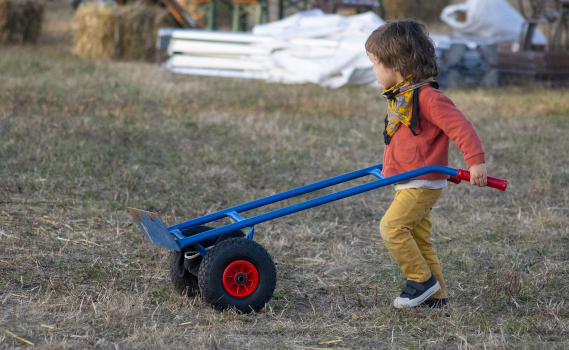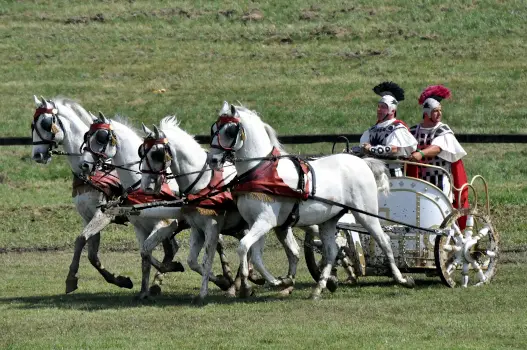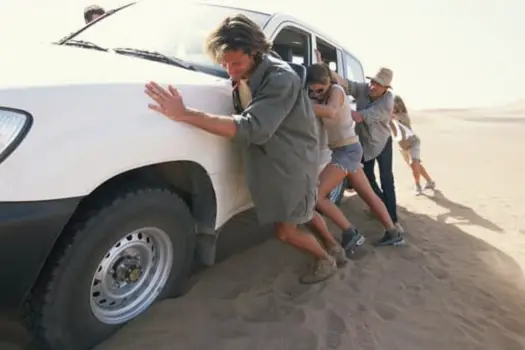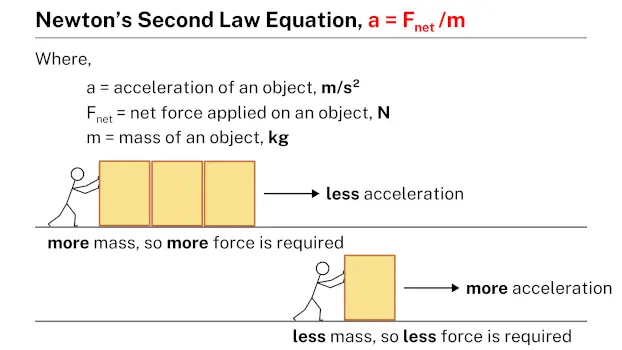Newton’s second law of motion states that the acceleration of an object is directly proportional to the net force applied to it and inversely proportional to its mass. In simpler terms, when a force is applied to an object, it will accelerate in the direction of the force. The greater the force applied, the greater the acceleration, while a larger mass will result in a smaller acceleration for the same force. This law mathematically relates the concepts of force, mass, and acceleration, providing a fundamental understanding of how objects respond to external forces.
Examples
Trolley

When pushing a trolley, Newton’s second law comes into play. According to this law, the acceleration of an object is inversely proportional to its mass. This means that when the same force is applied to both an empty trolley and a loaded trolley, the trolley with less mass will experience greater acceleration. The lighter trolley has less resistance to overcome due to its lower mass. As a result, the empty trolley will move forward at a faster rate compared to the loaded trolley, which has a greater mass and requires more force to achieve the same acceleration.
Box

When lifting objects, Newton’s second law applies to understand the relationship between mass, force, and acceleration. According to this law, the acceleration of an object is inversely proportional to its mass. Let’s consider a scenario where two persons are lifting courier boxes of different masses. If each person exerts the same amount of force to lift their respective box, the person handling the smaller box will experience greater acceleration, while the person handling the larger box will experience less acceleration. This is because Newton’s second law states that the acceleration of an object is inversely dependent on its mass. As a result, the person with the smaller courier box, which has less mass to overcome, will accelerate more compared to the person handling the larger box, which has a greater mass and requires more force to achieve the same acceleration.
Bicycle ride

Newton’s second law can be observed and understood while riding bicycles, such as comparing single-seat and two-seat bicycles. This law states that the acceleration of an object is directly proportional to the net force acting on it and inversely proportional to its mass. When applying this law to bicycles, it means that the acceleration of a bicycle is determined by the net force exerted on it and its mass. In the case of single-seat bicycles, the lower mass allows for a greater acceleration with the same applied force, making them easier to ride. On the other hand, two-seat bicycles, with their higher mass, require a greater force to achieve the same acceleration, making them more challenging to ride.
Tennis ball

When comparing the impact of a bat hitting a tennis ball and a football, Newton’s second law comes into play. This law states that the acceleration of an object is directly proportional to the net force acting on it and inversely proportional to its mass. Therefore, when the bat strikes both the tennis ball and the football, the resulting acceleration will depend on the net force applied and the mass of each object. Due to its lower mass, the tennis ball will experience greater acceleration for the same applied force compared to the football, which has a higher mass. This showcases how the mass of an object influences its acceleration as per Newton’s second law, where a smaller mass allows for a greater acceleration with the same force.
Wagon

Newton’s second law becomes evident when pushing a wagon. This law states that the acceleration of an object is directly proportional to the net force applied to it and inversely proportional to its mass. When a single person pushes the wagon, the greater mass results in slower acceleration due to the lower net force. However, when a group of people push together, the combined net force increases, resulting in greater acceleration and making it easier to move the wagon.
Horse-drawn vehicle

Newton’s second law is demonstrated when a horse attempts to pull a horse-drawn vehicle. The law states that the acceleration of an object is directly related to the net force applied to it and inversely related to its mass. When a single horse pulls the vehicle, the lower net force, combined with the greater mass of the vehicle, results in slower acceleration. However, when multiple horses (such as a team of horses) pull the vehicle together, the combined net force increases, overcoming the greater mass and leading to greater acceleration. This demonstrates how Newton’s second law highlights the relationship between net force, mass, and acceleration in the context of pulling a horse-drawn vehicle.
Wardrobe

When it comes to accelerating a wardrobe on the floor, Newton’s second law becomes evident as it demonstrates that the task is easier for a group of individuals working together compared to a single person. This is because the acceleration of an object directly depends on the net force applied to it. When a single person attempts to accelerate the wardrobe, the net force acting on it is relatively low, resulting in slower acceleration. However, when multiple individuals join forces to accelerate the wardrobe, the combined net force increases significantly, leading to greater acceleration and making the task easier to accomplish.
Car

Newton’s second law becomes evident when attempting to free a stuck car from the sand. This law states that the acceleration of an object is directly proportional to the net force applied to it and inversely proportional to its mass. When a single person pushes the car alone from the back, the lower net force results in slower acceleration due to the car’s greater mass. However, when multiple individuals join in to push the car, the combined net force increases, resulting in greater acceleration despite the car’s mass. This exemplifies how Newton’s second law establishes a relationship between the net force applied to an object, its mass, and the resulting acceleration, highlighting the need for additional force to overcome the car’s mass and facilitate its forward motion.
Equation

Newton’s second law equation, a = Fnet/m, establishes the relationship between the acceleration (a) of an object, the net force (Fnet) acting on it, and its mass (m). This equation states that the acceleration of an object is directly proportional to the applied net force and inversely proportional to its mass. By utilizing this equation, it becomes possible to quantitatively analyze and predict the acceleration of an object when the values of net force and mass are known.
Practice problems
Problem #1
A box with a mass of 2 kg accelerates forward slowly when a net force of 4 N is applied to it. What is the rate of acceleration of the box?
Solution
Given data:
- Mass of a box, m = 2 kg
- Net force applied to a box, Fnet = 4 N
- Acceleration of a box, a = ?
Applying the formula:
- a = Fnet/m
- a = 4/2
- a = 2 m/s2
Therefore, a box accelerates forward at the rate of 2 m/s2.
Problem #2
Calculate the acceleration of a wooden cart weighing 12 kg when a net force of 6 N is applied to it.
Solution
Given data:
- Acceleration of a wooden cart, a = ?
- Mass of a wooden cart, m = 12 kg
- Net force applied to a wooden cart, Fnet = 6 N
Applying the formula:
- a = Fnet/m
- a = 6/12
- a = 0.5 m/s2
Therefore, the acceleration of a wooden cart is 0.5 m/s2.
Problem #3
A wagon with a mass of 100 kg experiences a net force of 180 N. Determine the acceleration of the wagon.
Solution
Given data:
- Mass of a wagon, m = 100 kg
- Net force experienced by a wagon, Fnet = 180 N
- Acceleration of a wagon, a = ?
Applying the formula:
- a = Fnet/m
- a = 180/100
- a = 1.8 m/s2
Therefore, the acceleration of a wagon is 1.8 m/s2.
Problem #4
What is the acceleration of a horse-drawn vehicle weighing 400 kg when a net force of 800 N is applied to it?
Solution
Given data:
- Acceleration of a horse-drawn vehicle, a = ?
- Mass of a horse-drawn vehicle, m = 400 kg
- Net force applied to a horse-drawn vehicle, Fnet = 800 N
Applying the formula:
- a = Fnet/m
- a = 800/400
- a = 2 m/s2
Therefore, the acceleration of a horse-drawn vehicle is 2 m/s2.
More topics
- Frame of reference
- Newton’s first law
- Newton’s second law
- Newton’s third law
External links
- Newton’s second law – Examples – Mammoth Memory
- Newton’s Laws of Motion: Newton’s Second Law – GCF Global
- Newton’s Second Law of Motion – The Physics Classroom
- Newton’s laws of motion | Definition, Examples, & History – Britannica
- What is Newton’s second law? (article) – Khan Academy
- Newton’s Second Law of Motion – Indianapolis Public Library
- 5.3 Newton’s Second Law – University Physics Volume 1 – OpenStax
- Newton’s Second Law: Statement, Examples, and Equation – Science Facts
- Newton’s Laws of Motion – NASA (.gov)
- Newton’s Laws of Motion with Examples – Smore Science Magazine
- Application of Newton’s Second Law: Overview – Vaia
- Newton’s laws of motion – Wikipedia
- Newton’s Second Law of Motion : Definition, Formulas – Turito
- 5.3 Newton’s Second Law – General Physics Using Calculus I – UCF Pressbooks
- 4.4 Newton’s Second Law of Motion: Concept of a System – BCcampus Pressbooks
- Lesson Explainer: Newton’s Second Law of Motion – Nagwa Limited
- Newton’s Second Law of Motion | Overview & Examples – Study.com
- What are some daily life examples of Newton’s second law of motion? – Quora
- What is Newton’s Second Law of Motion? (Video) – Mometrix Test Preparation
- Newton’s Laws: Explanation, Review, and Examples – Albert
- Science in Action: Newton’s Second Law of Motion – Space Center Houston
- Newtons Second Law – Force – MCAT Content – Jack Westin
- What is an example that demonstrates Newton’s second law? – Socratic
Deep
Learnool.com was founded by Deep Rana, who is a mechanical engineer by profession and a blogger by passion. He has a good conceptual knowledge on different educational topics and he provides the same on this website. He loves to learn something new everyday and believes that the best utilization of free time is developing a new skill.
